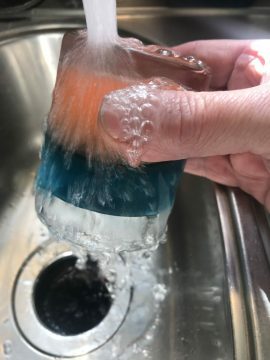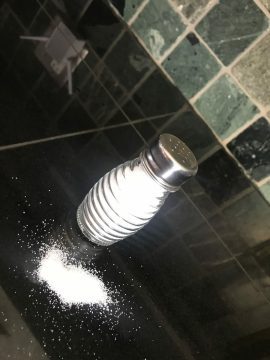
Playing with ice cube blocks is fun sensory activity full of learning potential. These blocks are equally fun on a hot summer day or in mid-winter. Here’s a look at some things to consider when making ice cube blocks.
It’s Pretty Simple
This isn’t rocket science. You can probably manage this DIY project just fine if you’ve ever stuck a freshly filled ice cube tray in the freezer and then, a few hours later, removed a cube of ice from the tray. Making ice cube blocks has three basic steps: 1) Put water in a container. 2) Freeze the water. 3) Remove the frozen water from the container.
We could end here, but that’d make for a pretty short article. So, let’s dig a bit deeper.
Select Your Container
Most any container that will hold water will work, but there are two things to keep in mind when picking your containers. First, thin plastic containers tend to expand as the ice freezes and you end up with a slightly deformed cube. It’s no big deal–unless you were really needed the block to be the exact shape of the unfrozen container. Second, your container’s shape matters. Not all containers will allow your cube to easily slip out. For example, the image below shows a beautiful ice block that will not come out of the class because it’s middle is wider than the rim of the glass. (I waited about 10 minutes and it melted enough to slip out.)

Get creative with your containers. I ransacked the kitchen and bar hunting for interesting shaped containers and was really happy with what I found. Another container consideration if you want to make a big batch of identically shaped blocks: How many of these containers do I have? If you’ve got 10 identical cups, it’s easy to knock out 50 matching ice cube blocks–it’s a lot more work freezing them one at a time.
Consider Some Color
Ice colored ice cube blocks are just fine, but with a little effort you can add color and make them pop. A drop of food coloring or two into the water filled container and a quick stir is all it takes. You can also get color in other ways. We were happy with the purplish-red results adding a few drops of beet juice to the water. We also got a nice light brown result when we froze earl gray tea.
Creating two-tone blocks is easy. Freeze a bit of colored water, add more water of another color to the container, and pop it back in the freezer.

Please Release Me
There are three options for removing your frozen ice cube blocks from the confines of their containers.
The Flip And Wait. Just invert the container and wait for the cubes to melt enough to clunk out of the containers. Just stay close and check them periodically. You’ll probably hear them clunk when they release and fall into the sink. There are two downsides to this options:
- Waiting is hard
- If you’re not paying attention, you may forget about them, get busy with something else, and come back to sadness and disappointment

The Rinse And Catch. With this option, you flip the container and rinse it with warmish water until it releases and then catch the cube before it crashes into the sink. The upside is that this method is a bit faster. The downside is it can take a lot of water if you’re doing a lot of blocks.

The Combo Platter. The final cube release option is to give each container a quick rinse under warmish water and then pop them in the sink upside down until they clunk to freedom.
Whichever option you chose, we recommend that you pop your ice cube blocks back into the freezer as soon as they release so you don’t use any mass.
Are There Enough?
When it’s time to play, you’ll probably wish you’d made more. Make as many as your freezer capacity will allow. Two or three ice cube blocks will not be as fun as 20 or 30–200 or 300 would be even more exciting. A big supply of cubes also means you can keep the play going longer. Just keep part of your supply in the freezer while kids play with the first batch. As the first batch melts you can replenish the play from your freezer stash.










Pick A Place
This may come as a surprise, but ice cube blocks are slippery. To make stacking a bit easier, select a surface that has a bit of texture.
Concrete slab–Good. Skating rink–Bad.
Terry cloth towel–Good. Marble counter top–Bad.
Sandbox–Good. Freshly waxed tile floor–Bad.
Sprinkle Some Salt
Here’s a tip for stacking ice blocks: sprinkle some salt on the lower block(s) before adding a block to the stack. The salt creates friction and helps the slippery cubes bond.





Spice It Up
If ice cube block play isn’t exciting enough, here’s a couple ideas for spicing it up:
Add Shaving Cream. Kids can use it as mortar to hold their ice blocks together.
Add Sand. The slippery ice texture and the gritty sand texture are great together.
Add Mud. Like shaving cream, it makes great mortar.
Play In The Snow. Ice blocks and the snow play well together and they blocks melt a lot slower in the cold.
Play In The Water. Add the blocks to the water table.
Full Of Learning
Like most everything else children choose to do, building with ice cube blocks is full of potential learning. Kids will learn social-emotional skills, physical skills, cognitive skills, and language skills.
Updated 8.13.2019: Added Images and fixed a few typos.
Contribute content to Playvolution HQ
Brought to you by Explorations Early Learning
Browse Trainings
Post Author
Jeff Johnson is an early learning trainer, podcaster, and author who founded Explorations Early Learning, Playvolution HQ, and Play Haven.









